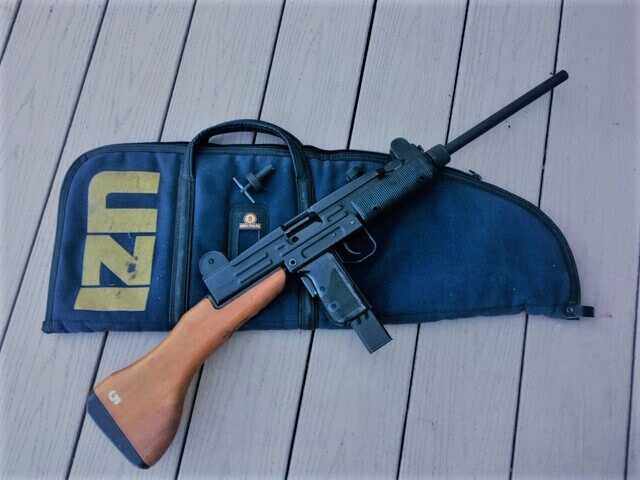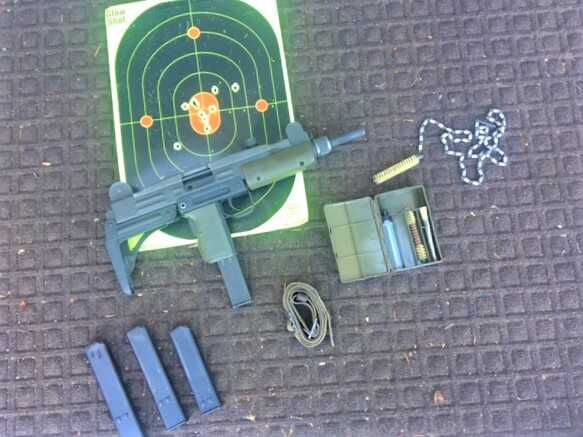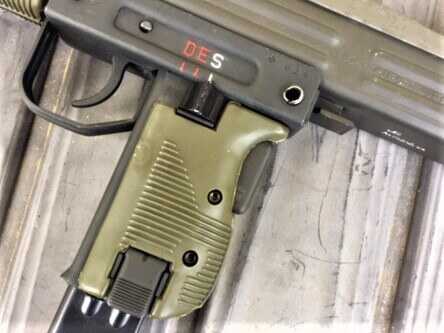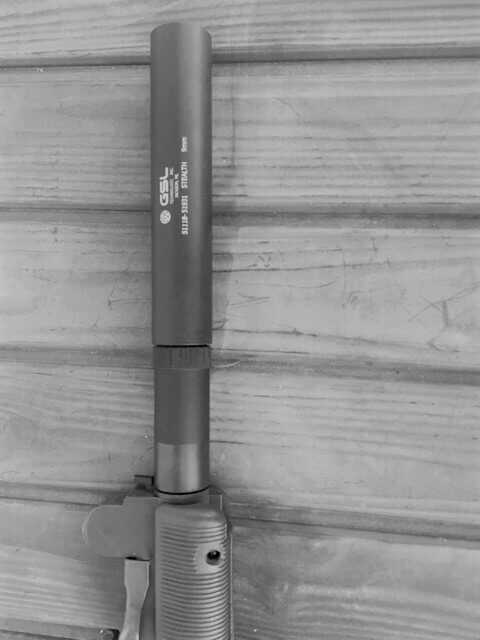
The Uzi is an Israeli-designed submachine gun that has been deployed across the globe. After gaining independence, the new nation of Israel was surrounded by enemies and needed simple weapons which could be produced locally. An army officer, Uziel Gal, designed the perfect Israeli solution. Adopted in 1954, the Uzi served with the Israeli army until 2003. Millions of Uzis served in over 90 countries, manufactured by Israel Military Industries, FN Herstal, and other manufacturers. Semi-auto variants were produced by many companies and can be found across America.
Is the UZI a washed up antique or a timeless classic? World-famous, star of countless movies, this girl is more than just a pretty face. The UZI is simple, reliable, and accurate enough, but it is from a time of stamped sheet metal guns. While not a thoroughly modern gun, it is easy and fun to shoot. The Uzi is still with us on GunsAmerica and in gun stores and gun shows, even during the great plague.
Gal combined ideas from several other designs into a stamped gun that was cheap to make and easy to maintain. The open bolt design is simple and improves cooling during sustained fire. The telescoping bolt has a hollow section that fits around the barrel forward of the chamber. This allows the magazine to be housed in the grip for a highly compact and well-balanced gun. The standard Uzi is 18.5 inches with the folding stock collapsed and has a 10-inch barrel with a rate of automatic fire of 600 rounds per minute (rpm). At 7.7 pounds, it is stable and accurate even on full auto. This made it a favorite of shooters everywhere from the Bundeswehr to Botswana and it still turns up in conflicts and crime sprees around the globe.
When I was a kid, I bought Soldier of Fortune magazine and eagerly read about the Uzi. I first saw a real Uzi in foreign weapons training at the Special Warfare Center and my first deployment in Special Forces sent me to Honduras. Israeli had sent weapons to the Somoza government in Nicaragua and when they fell, fleeing soldiers spread them all over Central America. I became very familiar with the Uzi and found it easy to shoot and effective. As we moved around the country I found that the Uzi made a great car gun. My theory was if we were ambushed, pistols were OK, but a few bursts of full auto and a couple of mini grenades would discourage our attackers long enough for us to break contact (ie run away).
The US Secret Service also found the Uzi useful. They used the Uzi as their standard submachine gun from the 1960s until the early 1990s. The role of the Uzi in close protection was revealed on March 30, 1981, when Secret Service Special Agent Robert Wanko pulled an Uzi out of a briefcase on a street in Washington D.C.

The Uzi In Media
I started naming movies that used the UZI in my head and soon realized there are dozens of Uzi movies. Going to the IMFDB site, you can see that from 1976’s “Raid on Entebbe” until 2020’s “Extraction”, the camera loves the unique lines of the Uzi. In 1984, the Terminator asked for it by name.

The Uzi has infiltrated pop culture in rap lyrics, anime, TV shows and video games.
Uzi Carbines
Most Americans experience the Uzi as a carbine. When the Uzi carbine appeared, it was a revolutionary idea to have a rifle shooting a pistol caliber. This started what was to become a wave of pistol caliber carbines. While similar in appearance to the Uzi submachine gun, it has several changes which prevent full auto conversion and a 16-inch barrel to meet the minimum rifle barrel length requirement for rifles allowing a stock. A clever semi-auto conversion uses a floating firing pin and fires from a closed-bolt. Uzi carbines were made in.22LR, 9mm, .41 AE, and .45 ACP.

Even though it had been around since the 1950s, the Uzi did not generate much interest in the United States until the 1980s. The CIA used the Uzi in limited numbers in Vietnam and the US Secret Service was covertly deploying them. This all changed in the 1970s when Uziel Gal left the Israeli military and moved to the United States, where he began working for Action Arms.
Harry Stern, the owner of Action Arms, decided to make a semiautomatic variant of the Uzi, and Gal himself designed a new closed-bolt mechanism for the Uzi and implemented the changes that needed to obtain ATF approval for a semiautomatic only version. The resulting design was then manufactured by Israeli Military Industries and imported by Action Arms. The new Uzi was introduced at the 1980 SHOT Show. Action Arms also imported a Model 45 and Model 41, chambered in .45 ACP and .41 Action Express.
Action Arms sold 72,000 Uzis before imports of the IMI semi-automatic Uzi ended in 1989 with the ban on the importation of non-sporting rifles. This was just the beginning. Even though it’s been over 30 years since they were imported, the Uzi can still be found on GunsAmerica, gun stores, and gun shows. The IMI Uzi carbine is the gold standard of semi-automatic Uzis. If you want an Israeli gun, there are available but prices on these reflect their limited availability.
In the 1980s, Group Industries started making Uzi semiauto carbines and full auto guns for sale in the US (which was legal at the time). Group used the same stamping dies for both receivers and heat-treated the receiver and parts for both guns. When the law changed to prohibit the sale of new machineguns to civilians, Group changed the model number to HR4332S (the number of the new law) to identify it as having a semi-automatic receiver. The Group Industries Uzi carbine is a faithful recreation of the IMI carbine. Group stamped out nearly 20,000 of the semi-automatic receivers, but very few of them were assembled. Vector completed and sold many of these guns. My Uzi carbine is a Group Industries model HR4332S.
In the 1980s the Chinese were importing millions of guns, mostly SKS and AKs. Norinco (North China Industries) got into the Uzi game with an unlicensed copy of the IMI Uzi carbine but importation into the United States was blocked because of infringement on patents held by Action Arms. Somehow, in 1994, Norinco managed to import 10,000 modified Uzis with wood thumbhole stocks. The Norinco Uzi originally sold for the same retail price as the IMI Uzi carbine but quality problems and poor fit and finish made them unpopular. They were eventually dumped by CDNN Sports at very low prices and $350 Uzi carbines turned up all over the country.
The latest Uzi carbine is the Century Centurion UC-9, made between 2010 and 2015. Their receivers are very accurate reproductions of the original IMI receivers, stamped by Global Machine and Tool in Texas. Using a combination of surplus Uzi parts from the German army and US-made parts the UC-9 is a functional, low-cost Uzi with mixed fit and finish because of various parts sources.
If you want to attach a wooden stock, the ATFE requires that it must be modified to permanently attach it. This article from uzitalk.com is extremely helpful.
UZI Full Auto

There are a couple of ways to get a full auto Uzi. There are a few pre-1986 (the date the new law took effect) transferable guns that can be sold to civilians. I found quite a few online at prices ranging from $7,000 to $10,000. Another option if you have the license from ATF is to convert an Uzi carbine. This is not a simple process. I started with a Century Centurion UC-9 and surplus MP-2 parts from the German army. The semi-auto Uzi has numerous modifications to prevent the use of full auto parts. Precise amounts of metal have to be moved even then some tinkering is required for proper functioning.

The UC-9 is a good receiver and I was able to produce a well running Uzi. It is a functionally faithful replica of the German Army MP2A1. The German Bundeswehr (Army) used the Uzi from 1959 to 2007 for tank crews and support soldiers. The MP2 was fitted with the IDF-style wooden stock and the later MP2A1 was fitted with the metal folding stock. It was replaced with the Heckler & Koch MP7 Personal Defense Weapon in 2007.

Uzi Tech
The Uzi is constructed from stamped sheet metal, making it cheap and easy to manufacture than competing designs. It is very robust, but this design comes with a lot of weight. With relatively few moving parts, the Uzi is easy to strip and maintain. The central protruding pistol grip with its vertical magazine makes the gun well balanced but it is awkward to fire from prone.
The Uzi SMG uses an open-bolt, blowback-operated design. The open bolt design exposes the breech end of the barrel and improves cooling during rapid fire. This means the bolt is held to the rear when cocked with a fixed firing pin ready to fire meaning if the bolt goes forward, it shoots. The pistol grip is fitted with a grip safety which blocks the bolt. The ratcheted top cover prevents the bolt from inadvertently going forward when cocking.
A clever design feature is the telescoping bolt which wraps around the breech end of the barrel. This allows the barrel to be moved far back into the receiver and the magazine to be housed in the pistol grip, allowing for a heavier, slower-firing bolt in a shorter, better-balanced weapon.

The semi-auto carbine versions split the bolt. The top half of the bolt goes forward and chambers a round. The bottom of the bolt holds a floating firing pin which is released by the semi-auto sear. This is similar to a striker-fired pistol. This is a brilliant solution to ATF’s requirements and makes for a nice action on its own.

The steel Uzi magazine is among the best SMG magazines out there. The double stack feeds reliably and they are easy to load. The standard magazines hold 25 and 32 rounds. High quality IMI made surplus magazines are plentiful and cheap. This is a big plus for me.
Shooting the UZI
The weight of the Uzi makes it easy to shoot with very little felt recoil. The magazines are easy to load and very reliable. The Uzi makes a fun pistol caliber carbine. The wooden stock is more shooter-friendly and balances better. The fore-end is a little short for those used to the geometry of a full-length float tube, but it is very functional.
The selector is easy to manipulate for right-handers, lefties will have to use the support hand or their thumb. Reloading is a snap as hand meets hand in the pistol grip. The magazine release is on the left side of the mag well. In European fashion, you grasp the magazine with your support hand and hit the release. Righties use their thumb, lefties use the index finger. The central cocking handle is ambidextrous and works well.

The carbine fires from the closed bolt, so you don’t get the weight shift when you pull the trigger. There is no last round bolt hold open. The trigger is smooth and the reset is solid. The 16-inch barrel looks awkward but the gun doesn’t feel front heavy, even with a collapsible stock. The large diopter sights are easy to use but in low light or on a black target they can be hard to pick up. There is a Picatinny mount that fits on the top cover for a red dot, this will be my next project.
The A model sights adjust elevation and windage using the front sight. There is a special tool for this. There are no clicks so everything is feel and “that looks about right”. The B model sights have elevation in the front and windage in the rear. All models have a rear L shaped flip rear aperture with two positions marked “100” and “200”.

The fully automatic Uzi shoots better than I remembered. In spite of the rough metal stock, it feels OK on full auto. The rate of fire is very controllable and it is an easy gun to stay on target with a good stance and grip. The gun is solid and heavy in a good way. The weight shift when the bolt goes forward is minimal. At ten yards, the steady bounce lets you hold an entire magazine in a 10-inch circle.
Suppressing the UZI
The Uzi’s barrel nut makes the Uzi a great suppressor host. GSL’s 9mm Stealth suppressors are the most adaptable platform on the market. If you are going to pay a $200 Tax, you want to use this can in every 9mm application. Stealth’s modular design has interchangeable adapters for, well, everything, including a dedicated Uzi adapter. You do need a Short Barreled Rifle or a Machinegun to make this work. Conversion barrels make a Form 1 SBR easy. Why pay a bunch of tax stamps when you can just get adapters?

There are many reasons people own and use silencers (as the BATFE calls them). They can make your guns hearing safe and make your shooting discreet so your neighbors don’t complain. This is also a great training tool for new shooters.

Buying suppressors is a complicated process with wait times and paperwork. Choosing the right suppressor requires some education and research. Most buyers can’t test fire them. Even if your local store has a range, your dealer may not even have the model you want to try in stock. Many times you have to pay in advance. Another BATFE paperwork transfer can be done to return a suppressor, but that is a poor option. There is no replacement for product research.
Why to Buy
The UZI is much more than another old SMG. It is easy and fun to shoot. The UZI remains simple, reliable, and accurate enough. Uzi carbines can be found on GunsAmerica and in gun stores and gun shows. If you want to understand why this seventy-year-old still shows up at the range, check one out. They come in a variety of configurations and conditions. I have seen good guns from many manufacturers, but there are problem guns too. Let the buyer beware.


So Thompson and grease gun aren’t modern?
I wouldn’t call the Thompson or the M-3 pistol caliber carbines. Change my mind.
Since the German military used the shorter Israeli type 25-round magazine, I can see the Uzi being issued to tank crews (as well as other armored/tracked vehicle crews) but as was explained to me by the German Master Sergeant who trained me on its usage and maintenance (as well as the H&K G3), the Uzi was issued primarily to motorcycle scouts, motorcycle messengers, and senior NCOs.
This was in the summer of 1978 or ’79 when I was stationed in West Germany during a joint communications exercise between West German and US NATO forces.
Fitted with a wood stock the Uzi machine pistol was a joy to shoot, even on full auto. Recoil was virtually nil and muzzle climb was almost nonexistent.
One of my many treasured memories of being stationed overseas for 4 years. (US Army, 1974-1980)
Ever hunted jackrabbits with a selective fire Uzi? You don’t actually hit much but it’s loads of fun. A great little gun.
If you put a removable surplus wooden stock on an Uzi carbine, you have created an unregistered SBR. The wooden stock needs to be modified so it is non-removable to be legal.
Nice article but with a small oversight: Gal did not “combined ideas from several other designs”. Gal copied the Czech Sa vz 23.
https://upload.wikimedia.org/wikipedia/commons/9/92/Samopal_vz_25_TBiU_14.jpg
Hey Vlad, I would love to hear more about your experience with Czechoslovakian machineguns. The VZ-23 certainly influenced the design of the Uzi. Before them was the Beretta Model 1938 submachine gun which influenced them both.
The VZ had some clever features. The telescoping bolt and magazine well in the pistol grip were great design and were copied around the world.
While there is little that is totally new in firearms technology, the Uzi is significantly different than the SA VZ-23.
The VZ-23’s receiver is machined from a steel tube. The Uzi is square sheet metal. This made it much cheaper and easier to make.
Like the Steyr AUG, the VZ-23 uses a progressive trigger for select fire. Lightly pulling on the trigger will fire a single shot. Pulling the trigger farther to the rear in a continuous motion will fire fully automatic. The Uzi trigger is a more simple and reliable design.
Enjoyed the article. After 30 years of dreaming I bought an IMI UZI on Guns America last summer. Complete with case, original manual and catalog, and 6 mags, one of them original UZI, and dummy short barrel just for fun. It’s my pride and joy.
Have seen several UZI pieces in Iraqi Kurdistan with wooden stocks and ID stamping in the Farsi language (Persian) from the time of the reign of last Shah of Iran, Mohammad Reza Pahlavi. In particular in 1999, on Salam Street in Sulaymaniayh, I could have bought a UZI for 150 USD. Several Kurds I have met are gun collectors and have UZI pieces in their collections. My wife and I were teachers who volunteered to teach in the Kurdish region and were there the year after I retired from the Army in 2010.